![]()
![]()
![]()
Use LEFT and RIGHT arrow keys to navigate between flashcards;
Use UP and DOWN arrow keys to flip the card;
H to show hint;
A reads text to speech;
23 Cards in this Set
- Front
- Back
- 3rd side (hint)
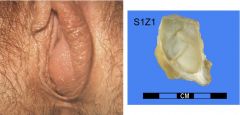
|
Bartholin Gland Cyst
|
Obstruction and possible secondary infection of the Bartholin Gland (posterior 1/3 of labia majora)
Tx: surgical incision & drainage |
|

|
Lichen Sclerosis
|
inflammatory disorder of the vulva
post-menopausal women association w/ autoimmune disorder whitish atrophic plaques, hyperkeratosis, acellular homogenous zone symptoms: itching, dyspareunia increased risk (15%) for squamous cell carcinoma |
|
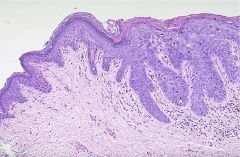
|
vulvular intraepithelial neoplasia
*note mitotic activity outside basal layer |
Preneoplastic Epithelial dysplasia
-undifferentiated (basaloid) (HPV16) -differentiated - older women 30-40% HPV associated squamous carcinoma precursor |
|

|
Squamous Cell Carcinoma Vulva
|
Most common vulvar malignancy (3% of gyn cancers)
exophytic or ulcerative, invading contiguous structures, lymph spread histo: keratin pearl formation verrucous carcinoma (HPV6/11) - condyloma-like mass, better prognosis |
|
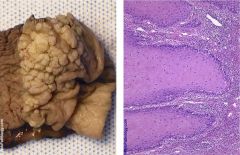
|
squamous cell carcinoma vulva
|
Most common vulvar malignancy (3% of gyn cancers)
exophytic or ulcerative, invading contiguous structures, lymph spread histo: keratin pearl formation verrucous carcinoma (HPV6/11) - condyloma-like mass, better prognosis |
|
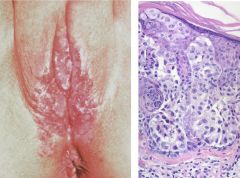
|
extramammary paget disease
|
red demarcated pruritic lesion
histo: large atypical cells w/ pale cytoplasm in epidermis rarely associated w/ malignancy |
|

|
atrophic vaginitis
|
post-menopausal women s/p estrogen withdrawal
atrophy of squamous epithelium symptoms: bleeding, dyspareunia |
|
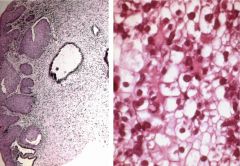
|
DES exposure
|
Used for high risk pregnancies, daughters affected
Vaginal adenosis (persistence of glandular epithelium) -grossly: red granular mucosa -histo: mucin producing/ciliated w/ squamous glandular epithelia Rarely transforms to clear cell carcinoma |
|
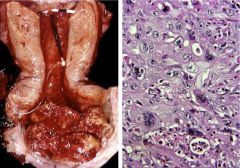
|
Squamous Cell Carcinoma (Vagina)
|
Elderly women, 90% of vaginal malignancies, arises from pre-existing dysplasia (sometimes HPV), poorly differentiated, no keratin pearls
|
|
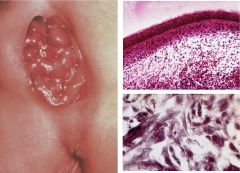
|
Embryonal Rhabdomyosarcoma
|
girls < 4 y/o, polypoid appearance
mesenchymal derived, composed of primitive spindle cells (possibly w/ cross striations (striated muscle derived)), myxomatous stroma presents w/ vaginal bleeding highly aggressive |
|
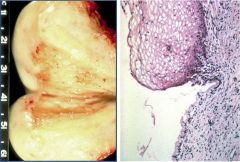
|
Embryonal Rhabdomyosarcoma
|
girls < 4 y/o, polypoid appearance
mesenchymal derived, composed of primitive spindle cells (possibly w/ cross striations (striated muscle derived)), myxomatous stroma presents w/ vaginal bleeding highly aggressive |
|
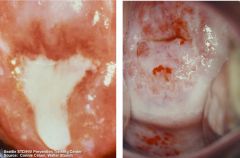
|
Cervicitis
|
Typically bacterial, cervix appears red & edematous w/ purulent exudate
chronic - lymphocytes, plasma cells, may lead to squamous metaplasia |
|
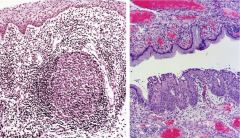
|
cervicitis
|
Typically bacterial, cervix appears red & edematous w/ purulent exudate
chronic - lymphocytes, plasma cells, may lead to squamous metaplasia |
|
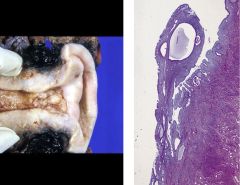
|
Endocervical Polyp
|
Benign polyp, lined by mucinous columnar epithelium w/ squamous metaplasia
may present w/ vaginal bleeding/discharge tx: excision or curretage |
|

|
Microglandular Hyperplasia
|
Progestin stimulation (preg, post-partum, contraceptives)
not be to confused w/ well-differentiated adenocarcinoma histo: uniform closely packed glands w/out intervening stroma w/ PMN infiltrate |
|
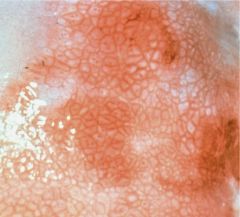
|
Mosaicism of arteries in Cervical Intraepithelial Neoplasia
|
|
|
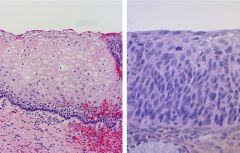
|
Cervical Intraepithelial Neoplasia
|
Arises at squamocolumnar junction
from mild atypia to full thickness dysplasia/carcinoma in situ Can spontaneously regress, low grade lesions have better prognosis Low grade - koilocytes (squamous cells w/ clearing of cytoplasm) High grade - full thickness changes w/ prominent atypia CIN --> Carcinoma in situ ~10 yr |
|
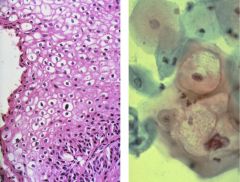
|
HPV infection
|
Episomal form (HPV6/11) - active replication and accumulation of virus (low grade)
Integrative form (HPV16/18) - virus incorporated into genome |
|
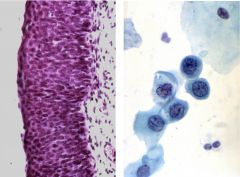
|
HPV
|
Episomal form (HPV6/11) - active replication and accumulation of virus (low grade)
Integrative form (HPV16/18) - virus incorporated into genome |
|
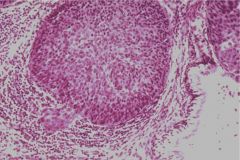
|
Squamous cell carcinoma (cervix)
|
40-60 y/o
HPV, multiple partners, early age of first coitus, cigarette smoking pap smear for early detection Microinvasion of basement membrane (limited metastatic potential) Direct invasion or lymphatic spread Prognosis dependent on clinical stage at dx Tx: radical hysterectomy w/ or w/out radiation |
|
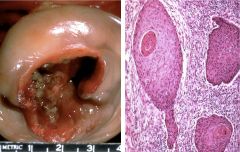
|
Squamous Cell Carcinoma
|
40-60 y/o
HPV, multiple partners, early age of first coitus, cigarette smoking pap smear for early detection Microinvasion of basement membrane (limited metastatic potential) Direct invasion or lymphatic spread Prognosis dependent on clinical stage at dx Tx: radical hysterectomy w/ or w/out radiation |
|
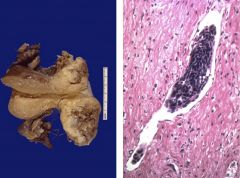
|
Squamous Cell Carcinoma
|
40-60 y/o
HPV, multiple partners, early age of first coitus, cigarette smoking pap smear for early detection Microinvasion of basement membrane (limited metastatic potential) Direct invasion or lymphatic spread Prognosis dependent on clinical stage at dx Tx: radical hysterectomy w/ or w/out radiation |
|
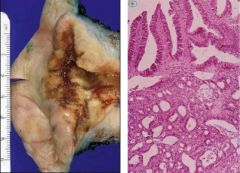
|
Adenocarcinoma (cervix)
|
50-60 y/o
HPV, multiple partners, early age of first coitus, cigarette smoking precursor lesion (cervical glandular intraepithelial neoplasia) originate near squamocolumnar junction CIN coexists in 40% similar spread as squamous carcinoma w/ poorer prognosis |

